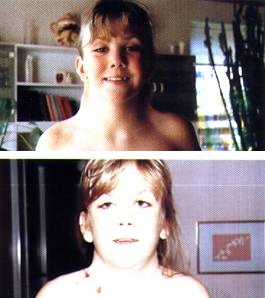WBR0114: Difference between revisions
Jump to navigation
Jump to search
Rim Halaby (talk | contribs) No edit summary |
Rim Halaby (talk | contribs) No edit summary |
||
| Line 21: | Line 21: | ||
|SubCategory=Endocrine, Reproductive | |SubCategory=Endocrine, Reproductive | ||
|Prompt=A 15-year-old girl is evaluated for failure to experience menarche. The patient is 1.45 m (4’ 9”) tall, has a broad chest, low hairline and a webbed neck. Which of the following is most likely associated with this patient's condition? | |Prompt=A 15-year-old girl is evaluated for failure to experience menarche. The patient is 1.45 m (4’ 9”) tall, has a broad chest, low hairline and a webbed neck. Which of the following is most likely associated with this patient's condition? | ||
|Explanation=The patient in this vignette is affected by [[Turner syndrome]]. Turner syndrome is caused by the lack of one copy of the X chromosome in females. Patients therefore have the genotype 45,XO. There are characteristic physical abnormalities, such as short stature, swelling, broad chest, low hairline, low-set ears, and [[webbed neck]]s. Females with Turner syndrome typically experience gonadal dysfunction (non-working ovaries), which results in [[amenorrhea]] (absence of menstrual cycle) and [[sterility]]. Turner syndrome is also associated with cardiac abnormalities such as preductal [[ | |Explanation=The patient in this vignette is affected by [[Turner syndrome]]. Turner syndrome is caused by the lack of one copy of the X chromosome in females. Patients therefore have the genotype 45,XO. There are characteristic physical abnormalities, such as short stature, swelling, broad chest, low hairline, low-set ears, and [[webbed neck]]s. Females with Turner syndrome typically experience gonadal dysfunction (non-working ovaries), which results in [[amenorrhea]] (absence of menstrual cycle) and [[sterility]]. Turner syndrome is also associated with cardiac abnormalities such as preductal [[coarctation of the aorta]], and [[bicuspid aortic valve]]. Turner syndrome is associated with lymphatic dysfunction causing [[lymphedema]] of the hands and feet as well as [[cystic hygroma]]s which result in the webbed neck phenotype. Patients can have renal abnormalities too, such as [[horseshoe kidney]]. | ||
A patient with Turner syndrome and webbed neck is pictured below. | A patient with Turner syndrome and webbed neck is pictured below. | ||
| Line 33: | Line 33: | ||
|AnswerCExp=While preductal coarction of the aorta is associated with Turner syndrome, the patients typically have decreased estrogen. | |AnswerCExp=While preductal coarction of the aorta is associated with Turner syndrome, the patients typically have decreased estrogen. | ||
|AnswerD=Decreased estrogen, horsehoe kidney | |AnswerD=Decreased estrogen, horsehoe kidney | ||
|AnswerDExp=Turner syndrome is associated with [[ | |AnswerDExp=Turner syndrome is associated with [[horseshoe kidney]] and decreased estrogen due to gonadal dysgenesis. | ||
|AnswerE=Decreased LH, FSH, infertile if untreated | |AnswerE=Decreased LH, FSH, infertile if untreated | ||
|AnswerEExp=Turner syndrome patients have increased FSH and LH due to low levels of estrogen. | |AnswerEExp=Turner syndrome patients have increased FSH and LH due to low levels of estrogen. | ||
Revision as of 01:25, 21 May 2014
| Author | [[PageAuthor::William J Gibson (reviewed by Rim Halaby, M.D. [1])]] |
|---|---|
| Exam Type | ExamType::USMLE Step 1 |
| Main Category | MainCategory::Genetics |
| Sub Category | SubCategory::Endocrine, SubCategory::Reproductive |
| Prompt | Prompt::A 15-year-old girl is evaluated for failure to experience menarche. The patient is 1.45 m (4’ 9”) tall, has a broad chest, low hairline and a webbed neck. Which of the following is most likely associated with this patient's condition? |
| Answer A | AnswerA::Increased LH, FSH, absence of functional SRY gene |
| Answer A Explanation | [[AnswerAExp::The SRY gene (also known as testis determining factor) is the gene on the Y chromosome that is responsible for the initiation of male sex in humans. Absence of functional SRY gene in an otherwise genetic male would cause Swyer syndrome. Swyer syndrome leads to phenotypic females with gonadal dysgenesis.]] |
| Answer B | AnswerB::Decreased LH, FSH, lack of Barr body |
| Answer B Explanation | [[AnswerBExp::While Turner syndrome is caused by the lack of a barr body, these patients typically have increased FSH and LH.]] |
| Answer C | AnswerC::Increased estrogen, preductal coarctation of the aorta |
| Answer C Explanation | AnswerCExp::While preductal coarction of the aorta is associated with Turner syndrome, the patients typically have decreased estrogen. |
| Answer D | AnswerD::Decreased estrogen, horsehoe kidney |
| Answer D Explanation | [[AnswerDExp::Turner syndrome is associated with horseshoe kidney and decreased estrogen due to gonadal dysgenesis.]] |
| Answer E | AnswerE::Decreased LH, FSH, infertile if untreated |
| Answer E Explanation | AnswerEExp::Turner syndrome patients have increased FSH and LH due to low levels of estrogen. |
| Right Answer | RightAnswer::D |
| Explanation | [[Explanation::The patient in this vignette is affected by Turner syndrome. Turner syndrome is caused by the lack of one copy of the X chromosome in females. Patients therefore have the genotype 45,XO. There are characteristic physical abnormalities, such as short stature, swelling, broad chest, low hairline, low-set ears, and webbed necks. Females with Turner syndrome typically experience gonadal dysfunction (non-working ovaries), which results in amenorrhea (absence of menstrual cycle) and sterility. Turner syndrome is also associated with cardiac abnormalities such as preductal coarctation of the aorta, and bicuspid aortic valve. Turner syndrome is associated with lymphatic dysfunction causing lymphedema of the hands and feet as well as cystic hygromas which result in the webbed neck phenotype. Patients can have renal abnormalities too, such as horseshoe kidney.
A patient with Turner syndrome and webbed neck is pictured below.
For a detailed discussion of Turner syndrome, see: Turner syndrome history and symptoms]] |
| Approved | Approved::Yes |
| Keyword | WBRKeyword::Reproductive, WBRKeyword::Chromosome, WBRKeyword::Karyotype, WBRKeyword::Turner syndrome, WBRKeyword::Ovulation, WBRKeyword::Genetics |
| Linked Question | Linked:: |
| Order in Linked Questions | LinkedOrder:: |
